He shot down a Messerschmidtt fighter, then later his own Mustang was hit, and he spent the last months of World War II as a German prisoner of war. Seven years afterward, American race driver John Fitch joined the Mercedes-Benz factory team. Were there any awkward feelings?
“Not at all,” he says. “We were all racers, just interested in racing.” Half a century has gone by, but that comradely spirit lives on. Mercedes invited Fitch to Mexico in November for a golden anniversary celebration of what the firm calls its “double victory”—first and second places—with prototype 300SL coupes in
La Carrera Panamericana, aka The Mexican Road Race.
Now 85, Fitch is one of the few surviving members of that 1952 team. Although he wasn’t the winning driver, he might well have been. He remembers having the consistently fastest Mercedes in the five-day-long, insanely dangerous but epic open-road event up the length of Mexico. What shot him down that time was recurrent tire and suspension trouble, which resulted in eventual disqualification.
Lean, dapper, unfailingly courteous, Fitch recounts the story with a genteel, it-doesn’t-matter smile. But the rapier eyes tell the truth. The old warrior really thought that race was his. Though he has long been a Connecticut Yankee, John Cooper Fitch actually was born in Indianapolis, on Aug. 4, 1917.
As his stepfather worked for the Stutz company there, and Stutz raced at Indy, John grew up knowing all about auto racing. At 21, thanks to “a small inheritance from my grandfather,” he set off for England, where in 1939 he attended what turned out to be the last-ever race meeting at the Brooklands speedway.
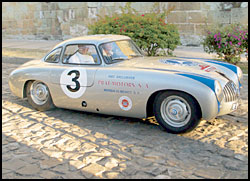
|
The 1952 300 SL pictured is the actual model that finished second in the 1952 La Carrera Panamericana. John Fitch finished fourth in a roadster in '52, but was disqualified. (Photo by Greg Jarem)
|
“My plan was to buy a horse and ride it through France to Italy,” Fitch recalls, those eyes now brimming with humor. “I thought that would be difficult, so I’d
require help along the way, and that way I’d get to know the people.”
But war was looming and officials disapproved of the young man’s venture. He was still in England when the Nazis invaded Poland. He tried to join the RAF, but was turned down. “They needed planes, not pilots.” So he went home and signed up with the U.S. Army Air Corps. Five days after Pearl Harbor he was commissioned and sent back to England, to attack enemy coastal defenses with an A-20 light bomber.
“A lovely airplane to fly, but a poor weapon,” John remembers. “Not enough range.”
Following his first tour, he transitioned to fighters and went back, this time in a
P-51 protecting bombers. “By the time I got there in 1944, the Luftwaffe was about finished, and they were playing it safe. They’d attack us when we were between cloud layers, dive down through our formation and disappear before we could do anything. And the Me262s, the jets, were a hundred miles an hour faster, so we couldn’t engage.”
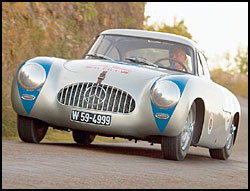
But the Allies knew the jets were operating from an autobahn, hiding in the forest alongside the highway. “It was a fluke,” John says of his kill. “I arrived as it was taking off, and I hit one engine. That meant it couldn’t get away. I shot again, and it went into the ground.”
Characteristically, the soft-spoken Fitch adds, “I was sorry to see the pilot didn’t get out.” Postwar, he was one of innumerable Americans enthralled by English sports cars. He claims he opened a tiny dealership specifically so he could have an MG TC of his own. Racing that and other cars seemed to come naturally to the ex-fighter pilot, and his talent soon became obvious all along the East Coast, from Bridgehampton to Sebring—and on to Buenos Aires.
His triumph in Argentina came in 1951. “A friend of mine had a Cadillac-Allard that the regular driver had crashed, and he agreed that if I straightened the frame, I could race it,” John explains. He adds that he’s no engineer, but it seemed logical to apply forces in the opposite direction to those that caused the damage. So he chained one end of the chassis to a tree and the other end to a truck, and kept pulling until the car looked right.
It must have been. The American drove that Allard to victory in the General Peron Grand Prix, a performance that earned him a kiss from Evita Peron and—he believes—the attention of Mercedes motorsports team manager Alfred Neubauer. In August 1952, after further impressing the Europeans with a good drive for Cunning-ham at Le Mans, Fitch was given a test on the Nurburgring in a 300SL.
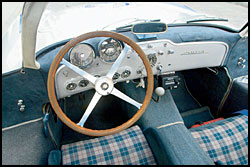
That factory special was Mercedes’ vehicle to get back into racing. An F1 program on the prewar scale was still beyond the reviving automaker, but engineer Rudi Uhlenhaut and his team saw they could make a prototype sports or GT car out of the 3.0-liter production sedan’s powertrain and suspension components. They tilted the heavy inline six to one side to lower its height, and to save weight they adopted the relatively new space- frame technology. Since that meant very thick sills, the doors of the coupes were hinged in the roof, “gullwing” style. Later in the season, more weight was saved by making a roadster version with small, conventionally hinged doors.
Hopped up with special heads, blocks and triple carbs (fuel injection didn’t come until the production model, two years later), the 300SLs had about 170 hp, weigh-ed less than one ton, and with tall gearing could top 150 mph. Decent numbers for any pure-blood racing car of the day, and impressive for a cobbled-together hot rod—especially one so nicely finished it might have been a street car.
The sleek silver bullets first raced in the 1952 Mille Miglia in May, where only the brilliant privateer Giovanni Bracco in his 3.0 Ferrari beat them. The 300SLs did win their second race, finishing 1-2-3 at Bern in Switzerland after the fastest Ferrari broke on the start line. Then Mercedes scored a sensational 1-2 at Le Mans, defeating the likes of Ferrari, Gordini, Jaguar and Talbot.
“It was like a light in the dark,” remembers Gunther Molter, a photojournalist (and former Luftwaffe pilot) who was part of the Mercedes entourage that season, and who came along to Mexico again in 2002.
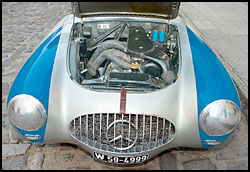
“Le Mans was a demonstration of the recovery of the [German] industry. Seven years before, the factory was a heap of weeds. Uhlenhaut started from nothing.”
Mercedes won again at the Nurburgring in August, in a Saturday support race to
the German Grand Prix (which was taken by Ferrari’s Alberto Ascari). The following Monday—his 35th birthday—John Fitch had his trial run. As he would later write in his autobiography, Adventure on Wheels, he found the SL “a sweetheart... light but solid... [an] instrument of victory.” He was equally impressed by Neubauer’s team
organization, and urged Mercedes not to put the 300SLs away, as had been planned, but to tackle one more event: La Carrera in November.
Fitch had done the race in 1951 with a Chrysler stock car. He didn’t finish, but
had been captivated by the grandeur of the challenge. Almost 2000 miles long, the
race route began at Tuxtla Gutierrez in the tropical south, wound up the mountainous spine of the country to elevations approaching 10,000 feet, and finished with miles of flat-out speed across the northern deserts to Ciudad Juarez. As in the one-day-long Mille Miglia, cars ran individually, but the distance was divided into eight legs over five days. Even more so than the Italian classic, Mexico’s real road race presented such random hazards as blind turns, unpredictable pavement, precipitous drops,
wandering livestock and excited spectators, some of whom seemed to regard the hurtling cars as bulls in a corrida.
Though fatal accidents were inevitable, the race was wildly popular, both with
the Mexican populace and with adventurous racers from around the world. The
publicity made it important to factories, and Ferrari took the 1952 race so seriously that it constructed a trio of brutally fast, 4.1-liter “Mexico” coupes and brought
in world champion Ascari to drive one. Bracco was there with his own Mille Miglia winner, and other threats included Phil Hill (Ferrari), Luigi Chinetti (Ferrari) and Jean Behra (Gordini). There were 85 cars in all that year.
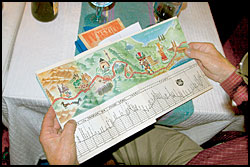
His memories refreshed by the presence in 2002 of the actual second-place car, John Fitch describes having to adapt to the 300SL’s tendency to oversteer, especially on bumpy corners. One wanted to keep the car in line, not lean on it. But that approach suited the nature of an open-road course, he points out. “Unlike a closed circuit, where you become so familiar that you can afford to brake late and clip all the apexes, in Mexico, as in the Mille Miglia, we tended to stay in the middle of the road. You could see around the turn better and avoid surprises.”
Helping avoid surprises was one role of the mechanics who rode aboard most cars. Fitch claims credit for the idea of compiling a list of hazard spots while prerunning the course, but in this case he and his partner, Eugen Geiger, spoke no word of the other’s language. They worked out hand signals. Once they’d started a leg, driver and riding mechanic were the only persons allowed to refuel, change tires or repair the car. Such work had to be done at the side of the road. That was the rule that caught Fitch. His race got off well. Driving a roadster, starting behind the team’s two coupes, he passed both in the first half of the tortuous, 330-mile opening leg to Oaxaca and reckoned he must be leading the race. Then a rear tire threw its tread at 140 mph. The flailing rubber tore up bodywork and broke a shock absorber.
Both coupes suffered tire problems of their own, and one took a buzzard through the windshield, briefly knocking out the passenger. Overnight, Neubauer’s crew
effected repairs for the next leg—and installed the famous “buzzard bars” on the damaged coupe—but the pattern was set. Mercedes simply didn’t have the right tires, and even personally hacking his own cooling and inspection holes (for his passenger to look through) in the rear fenders didn’t save Fitch from additional failures. Repeated abuse further damaged the suspension, and repeated hasty attempts to fix it weren’t successful.
Driving to one start line, the roadster’s misaligned front tires were making such a howl that Fitch knew they wouldn’t survive that day’s leg. He asked the officials if he would be allowed to take the starting flag, then double back to the team’s garage for further adjustment. “Si,” they said.
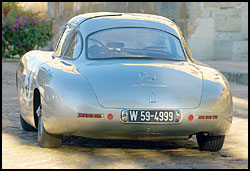
The car right at last, Fitch fought icy crosswinds to set the fastest time on the final run into Juarez, and finished fourth overall on accumulated times. But, in fact, his garage repair, despite being authorized on the scene, violated the clause about “at the side of the road.” He was out.
Despite all their own troubles, Karl Kling placed first in the “buzzard bar” 300SL with teammate Hermann Lang second. Chinetti came third with his Mexico Ferrari, the only one of the ferocious-looking Italian coupes to last.
His failure to win was a “bitter blow,” as he put it in his book, but today Fitch seems to retain nothing but fond feelings for the great race through Mexico. In light of his later and ongoing work in motorsports safety (www.racesafety.com), does he shake his head at his participation in the notorious La Carrera?
“Oh, no. We knew it was dangerous. But when you’re 35...”
Re-print atricle from AutoWeek On-line (17:46:23 Jan. 03, 2003)





